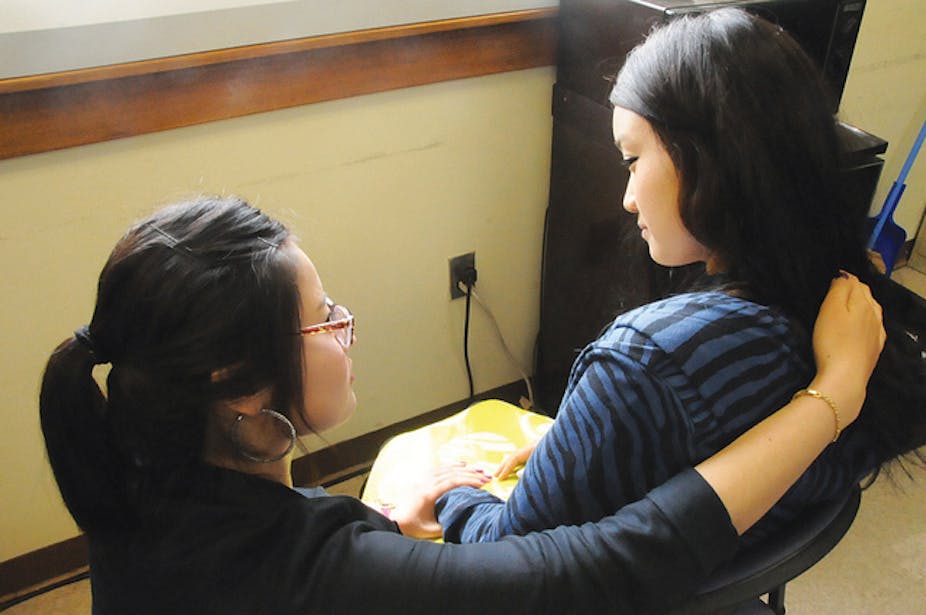Increasingly, governments rely on family carers to provide aged and disability care services. For many, family care is a demonstration of love and duty, but often there is little choice.
The word carer is an awkward bureaucratic term that helped to make unpaid work visible. It was first used in the United Kingdom in the 1980s to describe unpaid family care tasks and responsibilities.
In a 1971 British Medical Journal article titled “The forgotten”, an unnamed special correspondent tells the story of Miss E. F. Like many unmarried women of that time, Miss E. F. had to “sacrifice her own interests for those of her parents” and give up “an active life of work in a busy office” to care for her elderly mother.
The article highlighted the work of the National Council for the Single Woman and her Dependants (NCSWD), which was established in the early 1960s. The NCSWD successfully advocated for single women like Miss E. F. and, in 1971, an Attendance Allowance for people who needed ongoing care was introduced in the UK.
Five years later, carers were awarded an Invalid Care Allowance. This payment was seen as compensation for giving up paid work to care, but was only payable to single women.
By the 1980s, the specific concern of single women with care responsibilities had spread to other family members and in 1986 the Invalid Care Allowance was extended to married women. A new, more broadly defined category of carers emerged in UK social policy.

Australian policy makers have enthusiastically adopted the notion of carer and community care. Since the early 1990s, Australian governments have funded carer organisations and promoted the value of carers.
Recognition of unpaid care was a key goal of care advocates in the early 1990s in Australia. I was part of the team that conducted the first national Carers Consultation for Carers Association of Australia, as part of the International Year of the Family in 1994.
We argued carers were “living lives of quiet drama with little recognition or reward”. We highlighted the inadequate services for people with ill-health or disabilities, discrimination and the associated poverty and disadvantage that many people with care needs and responsibilities experience.
In 1995 Shiela Shaver and Michael Fine identified three possible approaches to the provision of “informal care” in Australia. The first was forced care through lack of public assistance; the second was the provision of support services to relieve caregivers; and the third was the development of a “shared care” between the family, community and the state.
Since then carers have become recognised – there is even a Carer Recognition Act 2010, which is well-meaning but largely symbolic. Recognition is an important first step in improving the rights of carers. But this shouldn’t translate to pressure on family members to take on caring responsibilities.
Increasingly, unpaid carers are seen as key providers of care services. Recent Productivity Commission reports on aged care and disability care illustrate the reliance on unpaid family carers, with the emphasis on supporting caregivers to keep on caring. The Productivity Commission report on aged care went so far as saying,“Their role is not only fundamental to those they care for, but for the functioning of the aged care system overall.”

Policy makers and academic researchers have focused on defining sub-categories of carers such as young carers, carers of people with a mental illness, Indigenous carers, and so on. But this categorisation obscures the common features of carers themselves, such as poverty. As a recent OECD report notes, “Working-age carers are at a higher risk of poverty. Caregiving is associated with a higher probability of experiencing poverty in Australia as in most other OECD countries, except in southern Europe. Women carers appear to be especially vulnerable to poverty risks”.
Women still tend to do most of the caring, even though women’s labour force participation has steadily increased from 43% in 1978 to 59% this year. And care work, whether paid or unpaid, remains undervalued.
Often, due to inadequate services and support, family members have little choice but to care – as Evelyn Nakano Glenn persuasively argues in her book Forced to Care: Coercion and Caregiving in America. This comes at a cost for carers and people with care needs.
People with care responsibilities need more than recognition or just information and emotional support – although these are important. They need more flexible and responsive workplaces, adequate income support, and well-funded affordable and accessible services so that they and the people they care for, and care about, can lead decent lives.
It remains unclear how the recent Productivity Commission inquiries will shape policy responses for people with care responsibilities and care needs. The proposed National Disability Insurance Scheme is a positive step towards the provision of more equitable care services for people with disabilities. The Every Australian Counts campaign is urging government to implement the NDIS. We’re now waiting to see how the government responds to the Inquiry into Caring for Older Australians.

